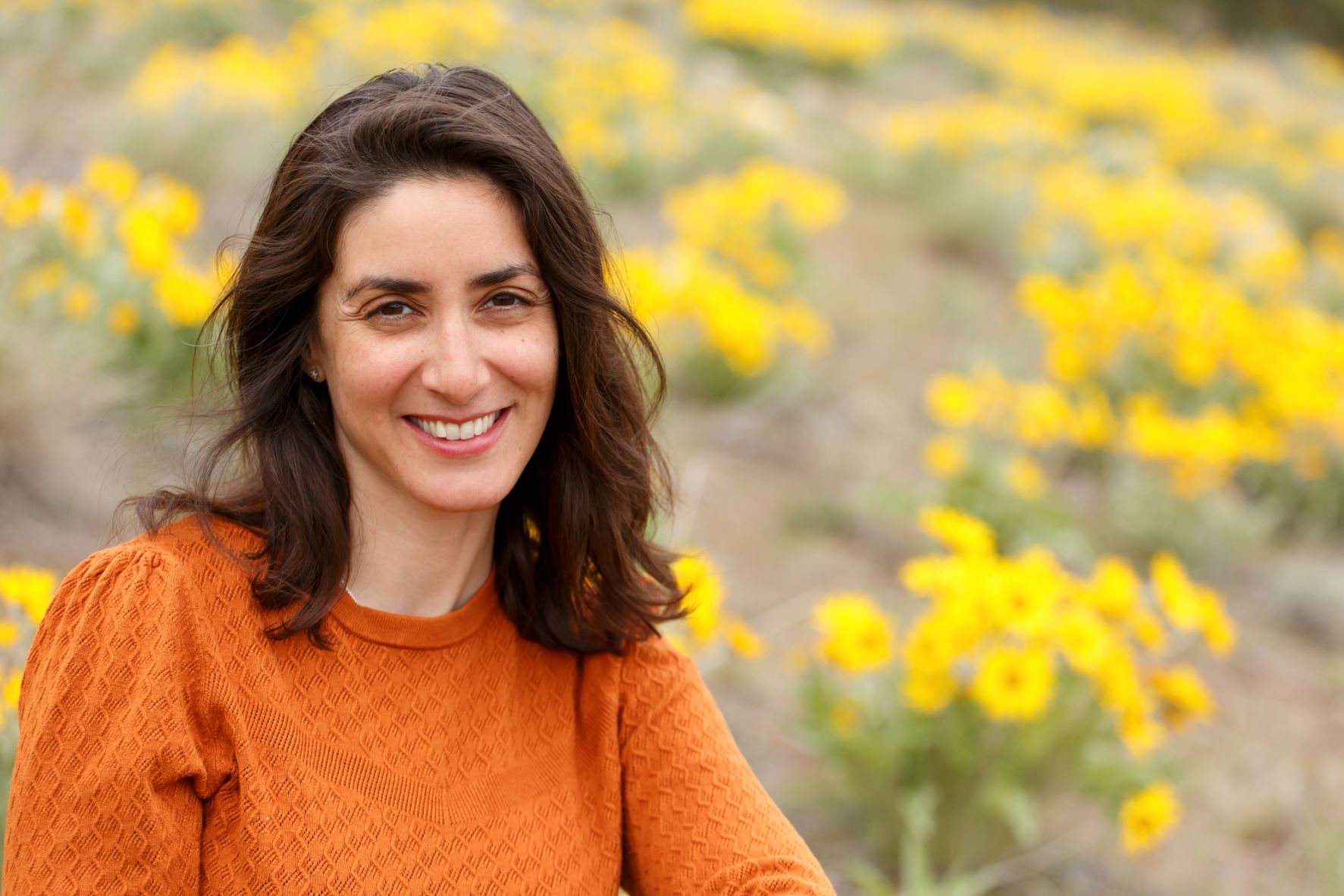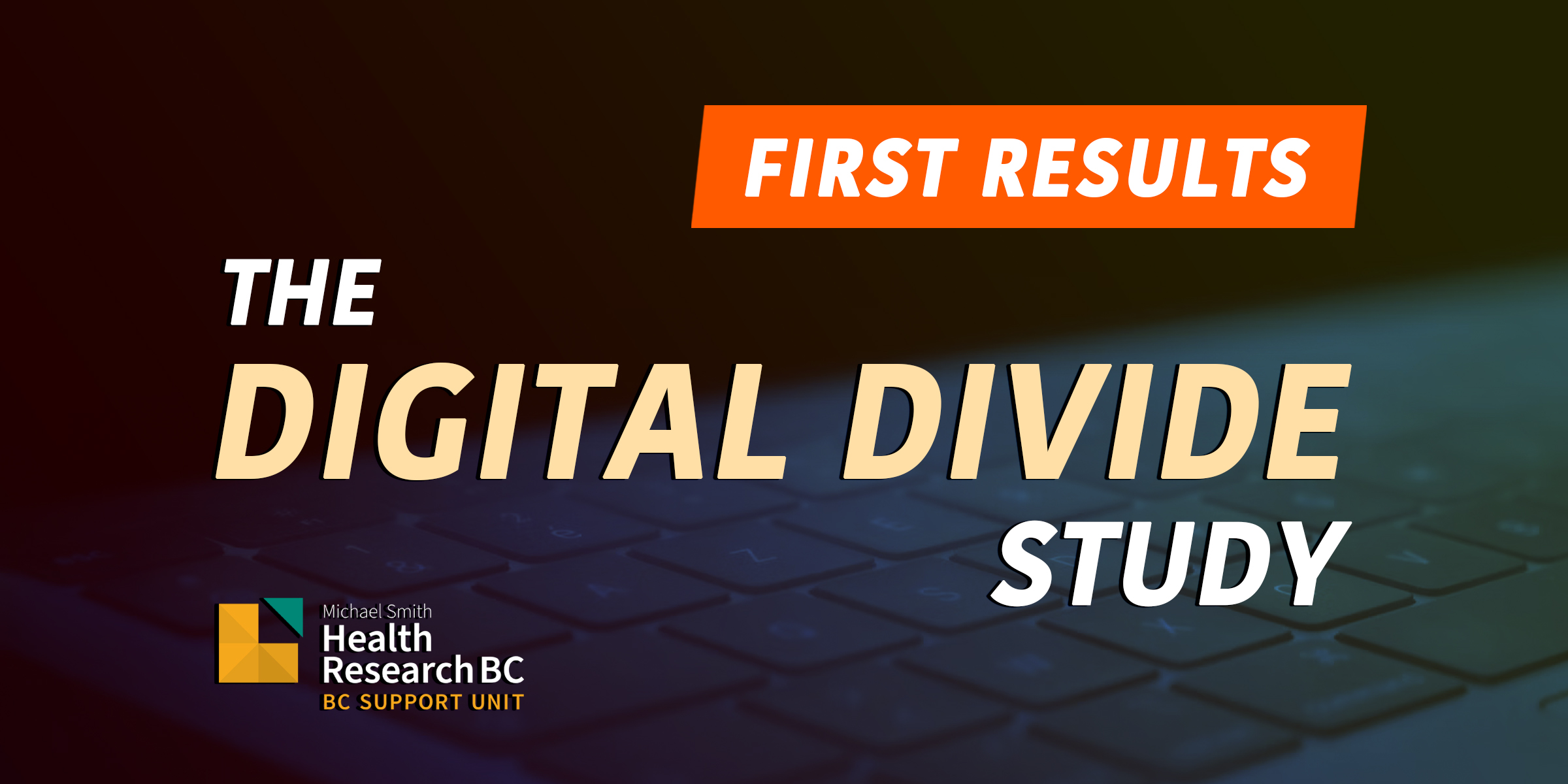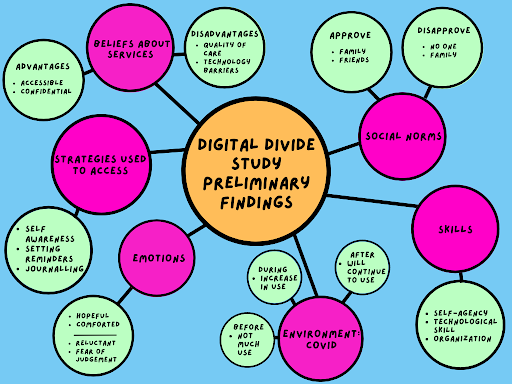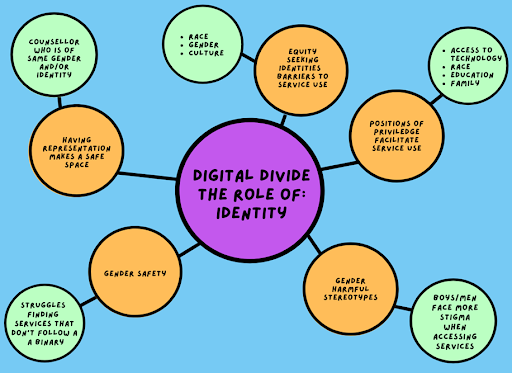It has been such an incredible learning experience conducting the digital divide qualitative study and during a pandemic! So many lessons learned! We had planned to start data collection for phase 2 of the digital divide study during spring/summer of 2020. Our plan was to interview youth accessing digital mental health technology at Foundry centres across BC. Click here to learn more about Foundry.

The purpose of the digital divide qualitative study was to understand the barriers and facilitators youth in BC experience when accessing digital mental health technologies. After March 2020, we made the decision to conduct virtual interviews instead. This actually seemed more fitting considering we were curious in understanding the digital divide. To learn more about the digital divide study check out our first blog . Also to learn more about phase 1 of our study that involved our scoping review check out this blog by co-lead Dr. Skye Barbic.
The findings from this study will help shape the development of tools and strategies to inform digital mental health services such as Foundry to increase accessibility for all youth in BC.
After extensive brainstorming and revamping our qualitative training sessions during the summer of 2020, we invited youth participants ages 12-24 to participate in an hour-long virtual open-ended interview conducted by our four talented youth research assistants. Check out Julia Gray’s blog to learn about the behind-the-scenes of being a youth research assistant. Our interview protocol was based on a decision-making framework called the Unified Theory of Behavior (Jaccard et al., 2015). We asked questions related to digital service use tapping into the different constructs from this framework (e.g. beliefs, emotions, strategies, skills, social norms, environment). We also asked questions related to how their identity (e.g. gender, race, ability) influenced their help-seeking, and how their use has changed since the pandemic. Thematic analysis was used to report patterns within the data. Undergraduate, graduate students, and youth were involved in the analysis phase. To get the behind the scenes of each phase of the qualitative research study check out graduate student Naomi Laurin’s recent blog.
So, what did we learn?
We are still analyzing our data (there is so much!), but we have some preliminary findings. We interviewed 45 youth, mean age of 19. Thirty-one percent were Female, 33% Male, and 38% Two-spirit and non-Binary. Of those youth 38% were Transgender. In terms of their race 42% were White, 18% Chinese, 13% Mixed ethnicity, 11% Indigenous, 2% Filipino, and 2% South Asian.
Youth reported:
- their beliefs about services
- who approves and/or disapproves (social norms) of them seeking services
- strategies and skills they use to access digital services, and
- emotions that get in the way and/or support them accessing services.
Prior to the pandemic youth reported not much use of digital health services. But this greatly increased during the pandemic. Youth reported that identity experiences (e.g., gender, race, culture) do influence access to digital mental health services. The findings from this study will help shape the development of tools and strategies to inform digital mental health services such as Foundry to increase accessibility for all youth in BC.
Check out our two diagrams below to learn more about some of the top responses to our interview questions.
Knowledge translation: Deliberative Dialogues
In our final phase of this study, we conducted a series of deliberative dialogues with four important stakeholder groups at Foundry: youth advisory council, parents’ advisory council, virtual care providers, and Foundry leadership. Deliberative dialogues (Plamondon, 2015) are a knowledge translation strategy where the research team synthesizes research findings and presents them to stakeholders. The stakeholders both validate findings and discuss application and movement for the future.
Some of the things we learned across the dialogues were:
1) The importance of increasing accessibility to all youth.
This means increasing digital health care access for youth of all genders, races, abilities, socio-economic statuses, and in all geographical locations.
2) The importance of learning about and supporting youth’s help-seeking.
Our virtual care providers discussed a need to learn more about the help-seeking process that youth experience before accessing services. They also expressed their desire to be more authentic and vulnerable when working with youth. In our parent’s dialogue, parents were interested in resources on ‘how’ to support their youth in the help-seeking experience, as well as discussing what are important qualities needed for caring adults to be role models to help support youth accessing services.
3) The importance of relationship-building with virtual care providers.
In our final dialogue, the youth advisory council spoke about the importance of relationship-building with virtual care providers and creating spaces that support this. This includes longer sessions, more time devoted to relationship building, therapists inviting youth back to another session, and check-ins over text. Youth also spoke about the importance of developing resources (e.g., what to expect when accessing services) for youth that help support the help-seeking process. This could be done using Q & A’s, TikTok videos, and videos showing real-life stories from youth (e.g., what does counselling look like, what does the space look like, what questions will counsellors ask you?)

Gurvaan Mann, one of our youth research assistants speaks about her experience with the deliberative dialogues: “The deliberative dialogues allowed for gaining the insight of a variety of perspectives that impact youths’ access to digital mental health technology, such as caregivers, youth, and service providers. In all the groups, there were many common themes that had previously been brought up in the qualitative interviews, such as the various accessibility barriers, limiting youth’s access to Digital Mental Health Technology. It was incredibly valuable being able to see the importance of having dialogues where many common concerns were seen from various perspectives and their approaches to decreasing those barriers. A barrier that stood out to me was the importance of resources being adaptive to the needs of youth, such as having virtual counselling that can allow for consistency, instead of it being brief.”
We have learned many lessons on how to engage diverse youth in research. Meaningful youth engagement takes time and resources.
Skye Barbic and Shelly Ben-David reflect on the impact of this work: “The digital divide project has set the foundation for youth digital health research and innovation in the province of BC. The real-time results have informed responses to the pandemic, future research planning and implementation, practice changes, and policy considerations for the future. We have learned many lessons on how to engage diverse youth in research. Meaningful youth engagement takes time and resources. Sustained and intention investments are needed to ensure programs of research are underpinned by consistent values of sustained engagement throughout the research cycle.”
We would like to thank all of the youth that participated in our research study! Stay tuned for more digital divide study findings, and knowledge translation activities in the coming months.
References:
Jaccard, J., & Levitz, N. (2015). Parent-based interventions to reduce adolescent problem behaviors: New directions for self-regulation approaches. Self-regulation in adolescence, 357-388.
Plamondon, K. M., Bottorff, J. L., & Cole, D. C. (2015). Analyzing data generated through deliberative dialogue: Bringing knowledge translation into qualitative analysis. Qualitative Health Research, 25(11), 1529-1539.

About Dr. Shelly Ben-David
I am an Assistant Professor of Social Work at UBC Okanagan. My program of research focuses on prevention and early intervention of mental illness among youth and young adults. I am interested in how young people make decisions about accessing both digital and in-person mental health services. I am also interested in how intersecting identities, culture, and community influence these decisions. I am passionate about engaging young people in the research process, and conducting community engaged research.






Leave a Reply